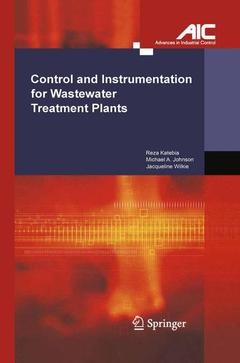Control and Instrumentation for Wastewater Treatment Plants, Softcover reprint of the original 1st ed. 1999 Advances in Industrial Control Series
Langue : Anglais
Auteurs : Katebi Reza, Johnson Michael A, Wilkie Jacqueline

The series Advances in Industrial Control aims to report and encourage technology transfer in control engineering. The rapid development of control technology impacts all areas of the control discipline. New theory, new controllers, actuators, sensors, new industrial processes, computer methods, new applications, new philosophies?, new challenges. Much of this development work resides in industrial reports, feasibility study papers and the reports of advanced collaborative projects. The series offers an opportunity for researchers to present an extended exposition of such new work in all aspects of industrial control for wider and rapid dissemination. The environmental aspects of all of our society?s activities are extremely important if the countryside; the sea and wildernesses are to be fully enjoyed by future generations. Urban waste in all its manifestations presents a particularly difficult disposal problem, which must be tackled conscientiously to prevent long lasting damage to the environment. Technological solutions should be seen as part of the available options. In this monograph, the authors M. R. Katebi, M. A. Johnson and J. Wilkie seek to introduce a comprehensive technological framework to the particular measurement and control problems of wastewater processing plants. Of course the disposal of urban sewage is a long-standing process but past solutions have used options (disposal at sea) which are no longer acceptable. Thus to meet new effluent regulations it is necessary to develop a new technological paradigm based on process control methods, and this is what the authors attempt to provide.
1 Process Modelling and Simulation Methods.- 1.1 Process Review.- 1.2 Modelling Preliminary and Primary Processes.- 1.3 Modelling the Activated Sludge Process.- 1.4 Uses of the Model.- 1.5 Modelling Principles.- 1.6 Conclusions.- 1.7 Further Reading.- 2 Process Control Structures.- 2.1 The Actuator — Plant and — Measurement Sequence.- 2.2 A Unified Actuator — Plant — Measurement Processes.- 2.3 Process Disturbances.- 2.4 Open Loop Control.- 2.5 The Feedback Control Loop.- 2.6 On-Off Control.- 2.7 Three Term Controllers.- 2.8 Cascade Control Loops.- 2.9 Ratio Control.- 2.10 Feedforward Control.- 2.11 Inferential Control.- 2.12 Advanced Control Features: Methods of Controller Adaptation.- 2.13 Conclusions.- 2.14 Further Reading.- 3 Supervisory Control and Data Acquisition Systems and Virtual Instrumentation.- 3.1 Introduction.- 3.2 Economic Benefits.- 3.3 A Classification For Supervisory Control Problems.- 3.4 Technological Background.- 3.5 Distributed Control System Technology.- 3.6 Functionality of the DCS.- 3.7 On Designing Supervisory Control.- 3.8 Virtual Instrumentation (VI) and a Design Exercise.- 3.9 Conclusions.- 3.10 Further Reading.- 4 Quality Control For Dynamic Processes.- 4.1 Introduction.- 4.2 Data Collection and Presentation.- 4.3 Elementary Statistical Measures.- 4.4 Process Variations.- 4.5 Process Control.- 4.6 Assessment of Process Stability.- 4.7 Process Capability Indices.- 4.8 Example.- 4.9 Conclusions.- 4.10 Further Reading.- 5 Sensors and Actuators.- 5.1 Physical Measurement: Level.- 5.2 Physical Measurement: Flow.- 5.3 Flumes.- 5.4 Analytical Measurement: Ion Selective Electrodes.- 5.5 Analytical Measurement: Dissolved Oxygen (DO).- 5.6 Analytical Measurement: Turbidity and Suspended Solids.- 5.7 ‘Self-Cleaning’ Sensors.- 5.8Actuators: Pumps.- 5.9 Conclusions.- 5.10 Further Reading.- 6 Data Communications.- 6.1 Introduction.- 6.2 Dumb Terminals and Smart Sensors.- 6.3 Digital Communication.- 6.4 The ISO 7-Layer Model.- 6.5 Distributed Communication Systems.- 6.6 HART Communication System.- 6.7 Fieldbus.- 6.8 Examples of WWTP Communications.- 6.9 Conclusions.- 6.10 Further Reading.- 7 Knowledge-Based Systems.- 7.1 Expert Systems in Process Control.- 7.2 Modelling of Complex Process Using Neural Nets.- 7.3 Fuzzy Logic Control.- 7.4 Conclusions.- 7.5 References.- 8 Wastewater Treatment Plants: An Exercise.- 8.1 Introduction.- 8.2 Control Systems.- 8.3 Alarms.- 8.4 Data Display.- 8.5 Fault Monitoring.- 8.6 DO Control Using LabVIEW.- 8.7 Further Reading.- Appendix A: Modelling and Control Demonstrations.- Appendix B: Author Profiles.
Authors are renowned in their field, working at the Industrial Control Centre Glasgow Professor Johnson is one of the series editors for the AIC and soon to be launched C & SP series A new and valuable tool for wastewater engineers and students alike, unique in its subject matter
Date de parution : 08-2014
Ouvrage de 275 p.
15.5x23.5 cm
Thème de Control and Instrumentation for Wastewater Treatment Plants :
© 2024 LAVOISIER S.A.S.


